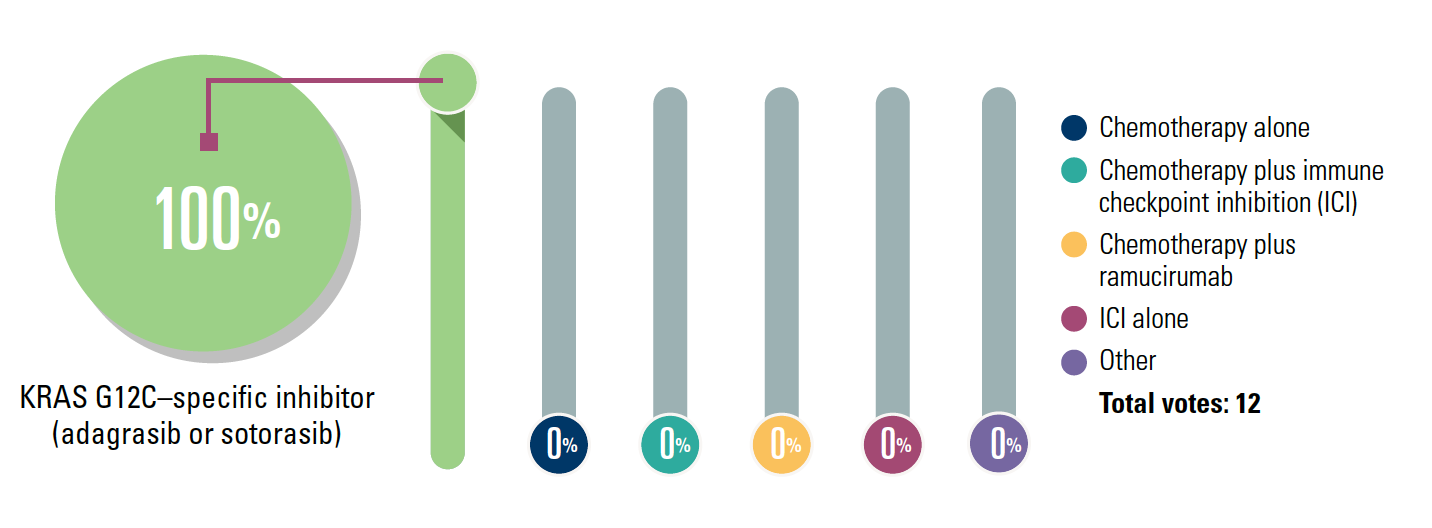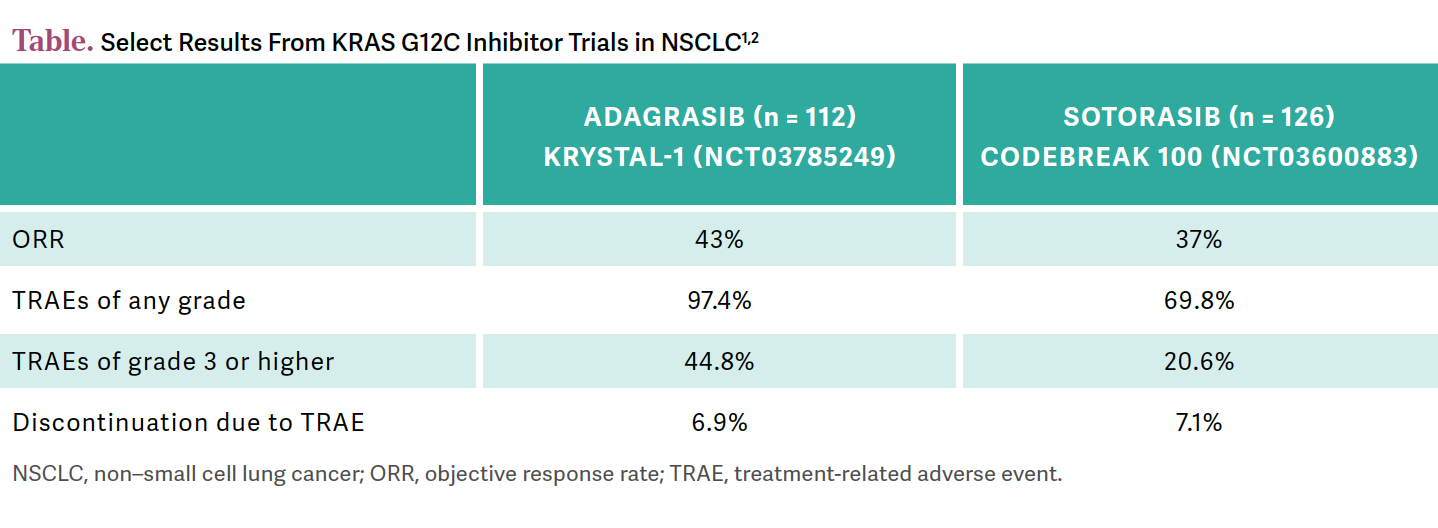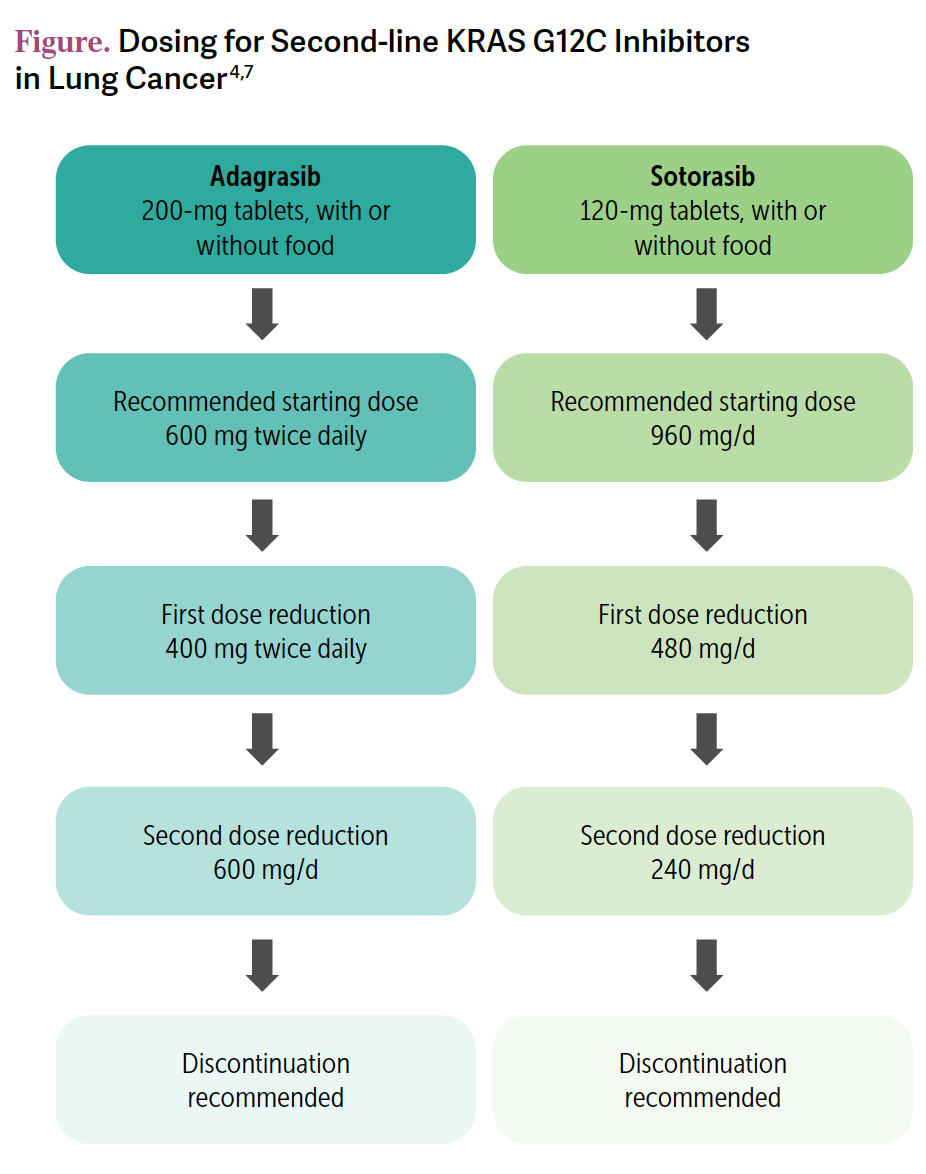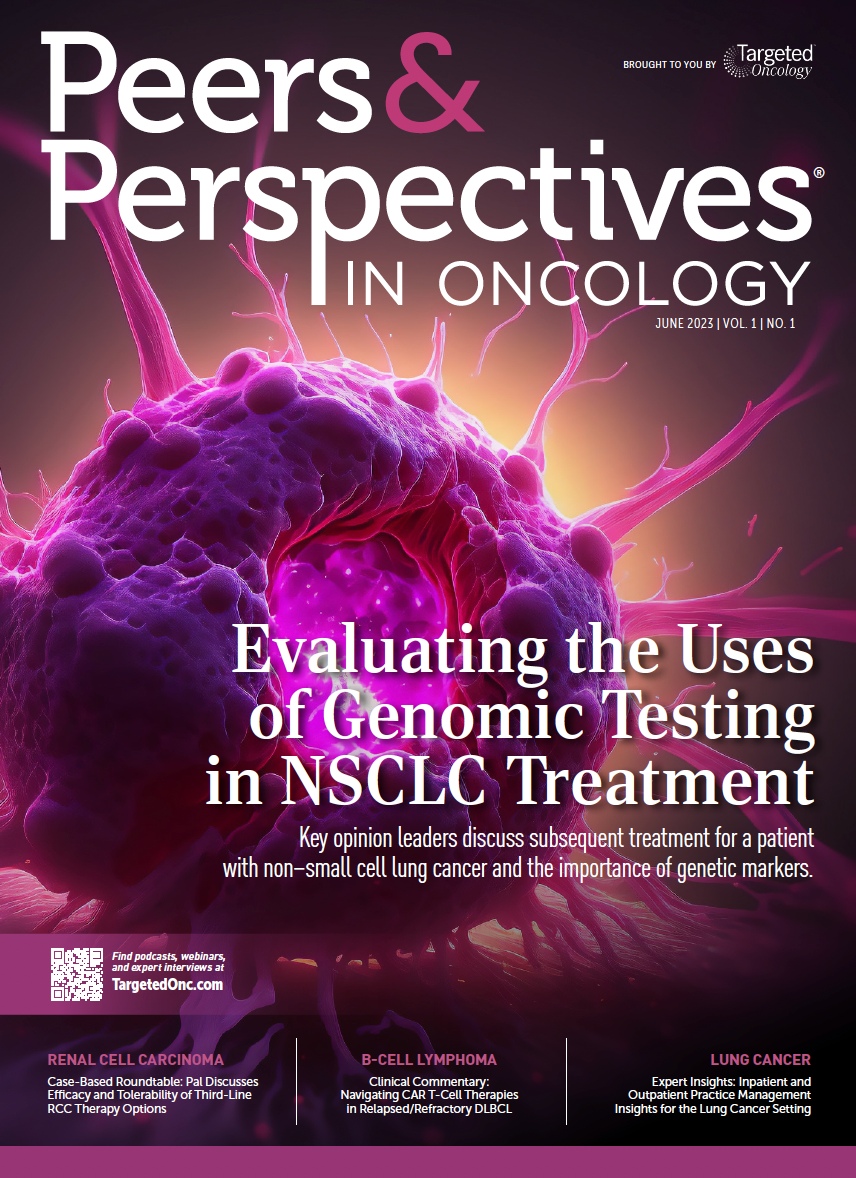PARTICIPANT LIST
Basel Shoua, MD
James Ewing, MD
Rupesh Parikh, MD
Katharine Thomas, MD
David Kahn, MD
EVENT REGION: Pacific and Southwest
During a Targeted Oncology™ Case-Based Roundtable™ event, D. Ross Camidge, MD, PhD, discussed dosing and toxicity concerns with the KRAS inhibitors adagrasib and sotorasib.
D. Ross Camidge, MD, PhD (Moderator)
Director of the Thoracic Oncology Clinical and Clinical Research Programs
Professor of Medicine
University of Colorado Anschutz Medical Campus
Aurora, CO

Basel Shoua, MD
James Ewing, MD
Rupesh Parikh, MD
Katharine Thomas, MD
David Kahn, MD
EVENT REGION: Pacific and Southwest
CASE SUMMARY
A woman aged 63 years presented with dyspnea on exertion, fatigue, anorexia, and a 5-lb weight loss. She had medically controlled diabetes and took an OTC gastric acid–reducing agent as needed for a sensitive stomach. She quit smoking 13 years prior (30 pack-years). Laboratory results were within normal limits.
A chest x-ray showed 2 right lower lobe masses. Chest/ abdomen/pelvic CT scan confirmed 2 masses (4.7 cm and 7.4 cm) in right lower lobe of lung and 2 liver lesions. PET scan showed activity in the right lower lobe and liver masses, and a brain MRI was negative. Bronchoscopy with transbronchial biopsy of the right lower lobe confirmed lung adenocarcinoma; staging: IVB adenocarcinoma with an ECOG performance status of 1. Tumor next-generation sequencing was positive for KRAS G12C and negative for other alterations. PD-L1 expression was 20% by SP263 assay.
She received carboplatin and pemetrexed (Alimta) plus pembrolizumab (Keytruda) and achieved a partial response at completion of 4 cycles of chemotherapy. She continued pembrolizumab maintenance.
Now, 14 months later, the patient is reporting worsening back pain and shortness of breath. A CT scan shows progression in the primary tumor and a new adrenal metastasis. A repeat MRI of the brain was negative.
Polling Question
“What systemic therapy are you most likely to offer this patient with KRAS G12C metastatic non–small cell lung cancer that has progressed on pembrolizumab maintenance after first-line chemotherapy plus pembrolizumab?”

DISCUSSION QUESTIONS
CAMIDGE: In terms of tolerability, this is always an issue with the KRAS G12C inhibitors. GI [gastrointestinal] AEs tend to be a big deal: diarrhea, nausea, vomiting, particularly with adagrasib. I think it perhaps has a bit more in the way of GI AEs than sotorasib.1,2 You can get fatigue and you can get some peripheral edema. Hepatotoxicity is usually a manifestation of an interaction with the prior checkpoint inhibitors. The longer away you are from the immunotherapy, the less hepatotoxicity there is. When they talk about [hepatotoxicity], they mean transaminitis. There are a few other [AEs to consider], but [primarily] GI AEs [as well as] some QTc [corrected QT interval] prolongation [were highlighted], [but QTc is]… usually something I largely ignore.1
Sotorasib’s AEs [were highlighted if they occurred] in more than 15% of patients. GI AEs were dominant, [as well as] transaminitis.2 The FDA has hammered [the manufacturer] Amgen and said, “You don’t have any data that 960 mg is the right dose.” They’re forcing them to explore lower doses, which may have perhaps the same efficacy but fewer AEs.3 But generally speaking, the clustering of the AEs is the same [as adagrasib]: GI, transaminitis, fatigue, edema.1,2 I don’t know whether one drug is more or less tolerable than the other in an individual patient.
[In terms of treatment-related AEs, there is a subtle suggestion that some of the GI AEs may be a little bit worse with adagrasib than sotorasib (Table1,2)]. You can dose reduce and dose modify. Because there are lots of pills with sotorasib, you have a bit more flexibility in that, but who knows what the FDA will come down at in terms of what the recommended dose is going to be—but at the moment it’s 960 mg.4

CAMIDGE: Having seen the data…are you reaching for adagrasib or sotorasib? Is it based on efficacy or safety or something else? Maybe the CNS [central nervous system] penetration?
SHOUA: I used sotorasib in a patient and diarrhea is a big issue. I would choose between the 2 of them by looking at the data. Sotorasib looks like a little bit… less toxic than adagrasib, but both of them are great for the second line in that you’re offering your patient who has metastatic disease quality of life by using an oral pill and not needing to come to the cancer center for infusions, so they have more quality time with their family. Because we’re treating a disease that is terminal, the good point is they can have the convenience of an oral option.
CAMIDGE: Do the CNS data on adagrasib or…sotorasib… sway you at all one way or another?
SHOUA: No, they don’t.
EWING: I’ve used sotorasib because we [participated in] the clinical study, so I have a little experience there. The data [are] slightly better than docetaxel, but certainly more expensive. I’m still going to use the targeted agent over the other one, but I’m not impressed with any of our options.
CAMIDGE: Do any of you feel a pressure to use this in the first line off label?
PARIKH: Only if the patient has a contraindication to a PD-1 [inhibitor].
CAMIDGE: They’re trying to get these drugs into the first line. Their challenge was that monotherapy is clearly not competitive with immunotherapy. Then there’s the challenge that they’ve been hard to combine with immunotherapy because of exaggerated transaminitis. Sotorasib essentially [showed] we can’t do that5 and adagrasib has shown some data with some transaminitis,6 but they’re trying to figure out whether it’s acceptable to push it into a first-line combination. But that’s a work in progress.
EWING: Outside of the combination, I can’t see using it over pemetrexed.
Discussion Questions
CAMIDGE: I don’t think the pill burden [is an issue]. If you can’t take pills, you can’t take pills. Honestly, whether you have to take 3 [adagrasib tablets] vs 8 [sotorasib tablets] doesn’t make any difference if you can’t take any pills. But technically, the pill burden is less for adagrasib. [We are familiar with] the AEs, but in terms of drug-drug interactions, some of these patients have comorbidities. You [should] have your clinical pharmacist make an assessment over that.
Does anyone care about the prolonged QTc interval [with adagrasib]? Does that influence your practice?
THOMAS: The only way it influences it is getting the baseline [electrocardiogram (ECG)] and then following it closely. It does make me a little nervous, but it’s interesting to hear you say that you’re not really concerned; it eases my mind a little bit.
CAMIDGE: Well, granisetron prolongs the QTc interval, [but] it doesn’t stop me from using granisetron.
THOMAS: Yes, it doesn’t stop me from using it. It’s just something I think about.
CAMIDGE: It appears as a black box warning and you [may] worry about it.7 But what do you do with it? [These patients] have a terminal disease vs some theoretical risk [of cardiac toxicity].
KAHN: Just out of curiosity, how often do you get an [ECG] to check for the QTc prolongation? Do you do it every 3 months?
THOMAS: Yes, I do it every 3 months.
CAMIDGE: I wonder whether that’s treating ourselves more than the patient. I think if it’s going to prolong, it happens relatively early.
THOMAS: I don’t know. I’ve always done it.
CAMIDGE: There’s nothing wrong with that. It’s pretty cheap.
SHOUA: I do the same. I check every 3 months.
CAMIDGE: If you’re going to start someone on one of these, what do you tell the patient?
PARIKH: The most important thing is the diarrhea management.
CAMIDGE: What do you tell them to do?
PARIKH: We give them prophylactic antidiarrheal medications up front. If the [OTC medication] doesn’t work, they have diphenoxylate/atropine [Lomotil] already on hand. If it’s during the week, they call us and we’ll tell them what to do. If it’s on the weekend, [I] tell them to stop the drug and call us on Monday.
CAMIDGE: How long do you think it takes to manifest the diarrhea?
PARIKH: From my experience, it’s after 2 or 3 months. It’s not up front. I haven’t seen it up front. The first couple of weeks, they [say], “This is not that bad.” Then in the third or fourth [week] they [say], “I’m starting to have more loose stools,” and then [they get] diarrhea.
CAMIDGE: Yes, my [experience is] somewhere between those two. I think it’s later than, for example, with the EGFR inhibitors. It’s weeks, but not days. The beauty is that dose reduction tends to work. You try the loperamide [Imodium], but if they’re struggling, I wouldn’t hesitate to dose reduce.
Is there anyone who would reach for adagrasib first? Sometimes it’s just that we’re more familiar with sotorasib. KRAS G12C mutations are relatively common. Sotorasib has been out there…2 years, so we’ve had time to become familiar with it. Adagrasib’s efficacy didn’t [impress us] compared with sotorasib; if anything, it may be a little bit more toxic. I think that is where things might change in the future.
The CNS [data] didn’t influence my practice because a [33.3% objective] response rate in the brain1 is not high enough that I would forgo radiation therapy. It will be interesting if adagrasib is tolerable in a first-line immunotherapy combination, but sotorasib isn’t. That’s the only thing that might change the balance here, but we’ll have to see how that plays out over the next year or so.
We touched on management of GI toxicities. If pneumonitis happens, we hold the drug and give steroids. It’s pretty rare. [For] dose reduction [of sotorasib], you go down from 960 mg [daily] to 480 mg to 240 mg [Figure4,7]. The FDA is requiring them to reexplore the 480-mg and 240-mg doses.3 [For] adagrasib you use 200-mg pills, so you go from 600 mg twice daily to 400 mg twice daily and then you go to 600 mg once a day.7 That’s mostly based on diarrhea.

REFERENCES
1. Jänne PA, Riely GJ, Gadgeel SM, et al. Adagrasib in non-small-cell lung cancer harboring a KRASG12C mutation. N Engl J Med. 2022;387(2):120-131. doi:10.1056/NEJMoa2204619
2. Skoulidis F, Li BT, Dy GK, et al. Sotorasib for lung cancers with KRAS p.G12C mutation. N Engl J Med. 2021;384(25):2371-2381. doi:10.1056/NEJMoa2103695
3. Nakajima EC, Drezner N, Li X, et al. FDA approval summary: sotorasib for KRAS G12C-mutated metastatic NSCLC. Clin Cancer Res. 2022;28(8):1482-1486. doi:10.1158/1078-0432.CCR-21-3074
4. Lumakras. Prescribing information. Amgen; 2021. Accessed April 26, 2023. https://bit.ly/41FnGgR
5. Li BT, Falchook GS, Durm GA, et al. CodeBreaK 100/101: first report of safety/efficacy of sotorasib in combination with pembrolizumab or atezolizumab in advanced KRAS p.G12C NSCLC. Presented at: 2022 World Conference on Lung Cancer; August 6-9, 2022; Vienna, Austria. Abstract OA03.06. Accessed May 2, 2023. https://bit.ly/41TJDc0
6. Mirati Therapeutics presents late-breaking results evaluating concurrent adagrasib and pembrolizumab in first-line advanced/metastatic non-small cell lung cancer (NSCLC). News release. Mirati Therapeutics. December 5, 2022. Accessed December 6, 2022. https://bit.ly/3uvlQ36
7. Krazati. Prescribing information. Mirati; 2022. Accessed April 26, 2023. https://bit.ly/3NbtOZT

Bispecific Antibodies and ADCs Deliver a Futuristic Horizon Across Lung Cancer Settings
October 23rd 2024Recent advancements in protein engineering, especially antibody-drug conjugates, show promise in lung cancer treatment, with ivonescimab outperforming pembrolizumab in PD-L1-positive advanced non-small cell lung cancer.
Read More